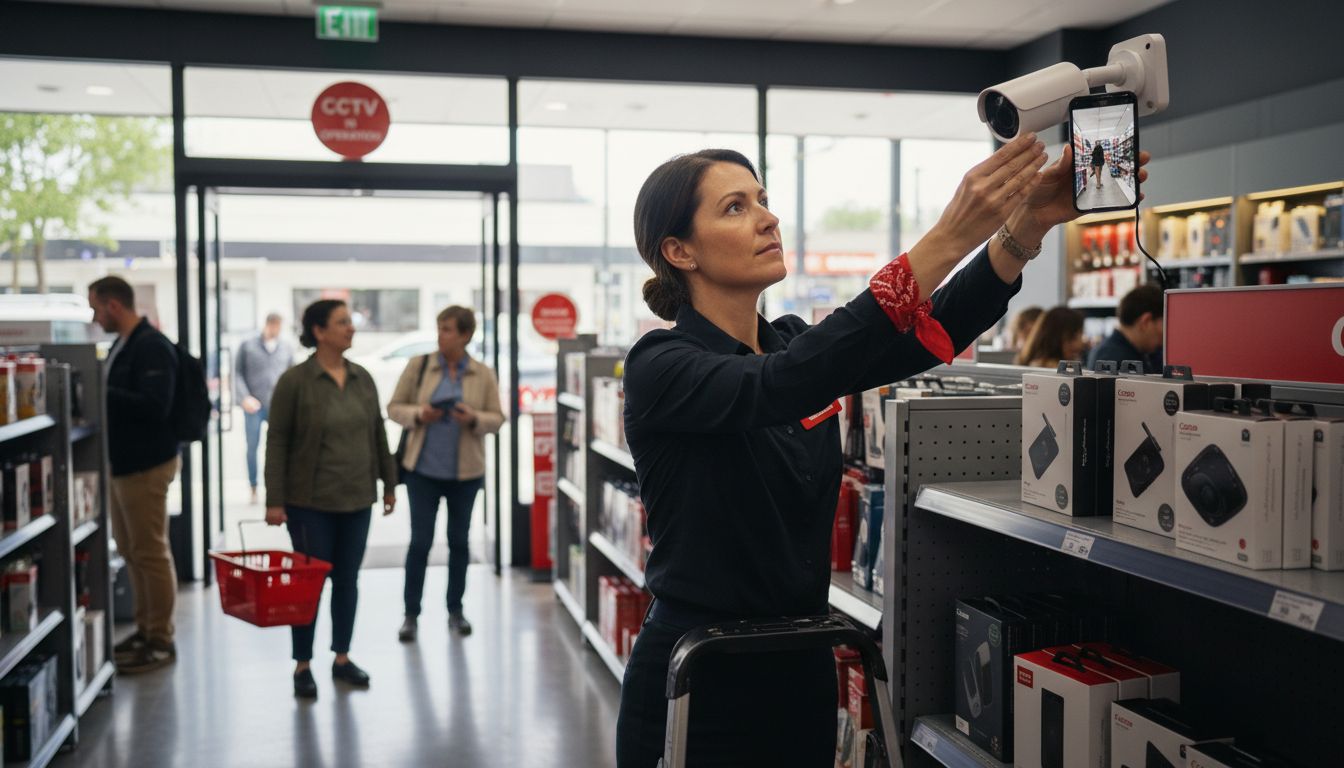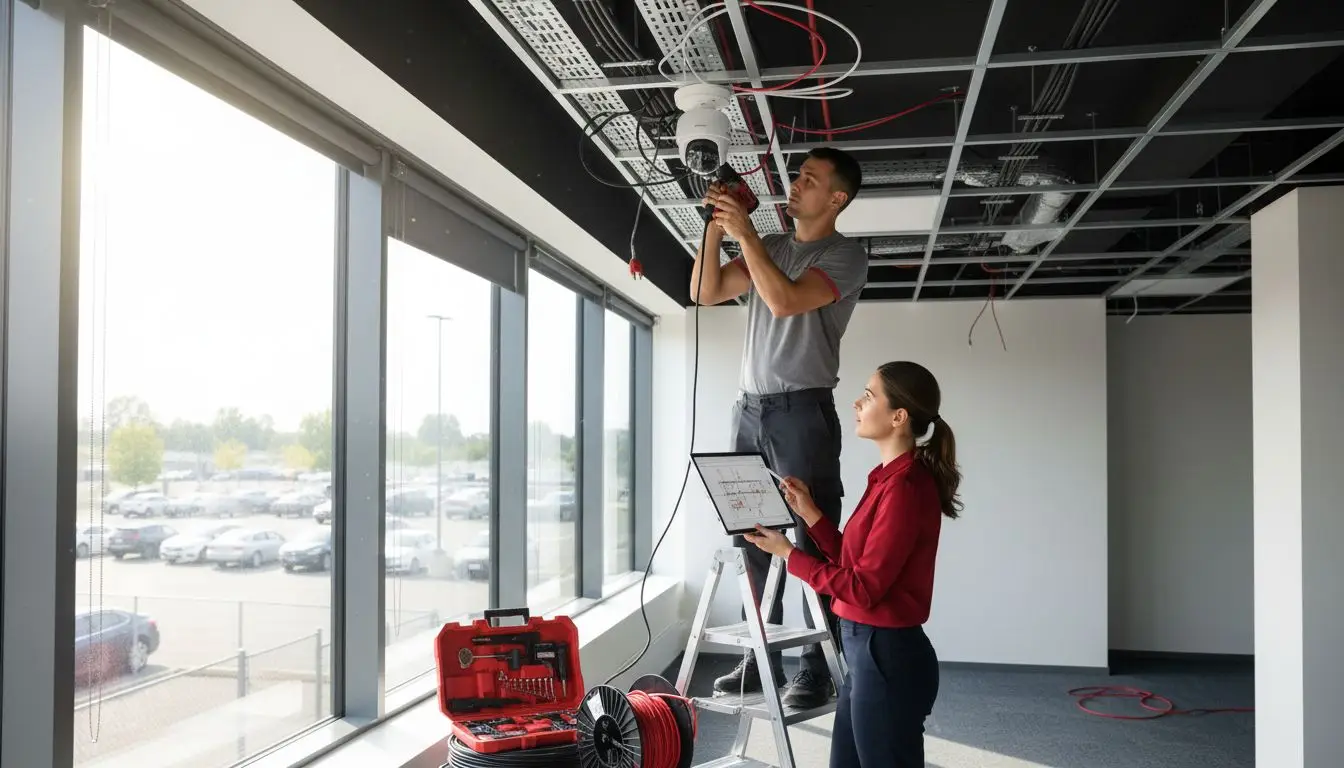Did you know that over one in three UK businesses experienced a security incident in the past year? Choosing between wired and wireless CCTV systems can make a real difference to your safety and peace of mind. Understanding how each system works, their strengths, and potential drawbacks helps you create a setup that keeps your property protected and compliant with strict UK privacy laws.
Table of Contents
- Defining Wired and Wireless CCTV Systems
- Key Differences Between Wired and Wireless CCTV
- Installation Processes and Practical Requirements
- Security, Reliability, and Maintenance Concerns
- Cost Factors and Budget Planning
- UK Legal Compliance for CCTV Installation
Key Takeaways
| Point | Details |
|---|---|
| Wired vs. Wireless | Wired CCTV systems provide stable performance with low signal interference, whereas wireless systems offer installation flexibility but can face signal interruptions. |
| Installation Challenges | Wired systems require extensive cabling and professional installation, while wireless systems facilitate quicker, DIY-friendly setups. |
| Maintenance and Security | Wired systems are generally easier to secure and maintain; wireless systems need regular checks for network and power integrity due to their reliance on external factors. |
| Cost Considerations | Wired setups entail higher installation costs due to labor, while wireless options tend to have lower installation expenses but may incur ongoing maintenance costs. |
Defining Wired and Wireless CCTV Systems
When it comes to modern security solutions, CCTV systems can be broadly categorised into two primary types: wired and wireless. According to network infrastructure experts, these systems differ fundamentally in how they transmit video signals and power to cameras.
A wired CCTV system transmits video through physical Ethernet cables, typically using Power over Ethernet (PoE) technology. These systems provide a dedicated, stable connection with consistent performance. The cables handle both data transmission and power supply, ensuring reliable connectivity without signal interruption. They’re particularly suited for locations requiring robust, uninterrupted surveillance such as commercial premises, warehouses, and secure facilities.
In contrast, wireless CCTV systems send video signals over the air using Wi-Fi or other wireless technologies. These systems offer remarkable installation flexibility, allowing cameras to be placed in locations difficult to reach with traditional cabling. However, they come with potential limitations. Wireless cameras require separate local power sources and can be susceptible to signal interference from other electronic devices or physical obstacles.

Key differences between wired and wireless systems include:
- Signal stability and consistency
- Installation complexity
- Power transmission methods
- Potential for signal interference
- Overall system reliability
For a comprehensive understanding of modern security camera technologies, check out our guide on wireless CCTV explained.
Key Differences Between Wired and Wireless CCTV
Choosing between wired and wireless CCTV systems involves understanding their fundamental technical and operational differences. According to research from industry security experts, each system presents unique advantages and challenges that can significantly impact your security infrastructure.
Installation complexity is a critical distinguishing factor. Wired CCTV systems require extensive cabling and professional installation, making them more time-consuming and potentially disruptive to existing spaces. In contrast, wireless systems offer remarkable flexibility, allowing cameras to be positioned in locations that would be challenging or impossible with traditional wired setups. As security infrastructure analysts note, this flexibility can be a game-changer for businesses with complex architectural layouts.
Signal reliability and performance vary between these systems. Wired CCTV ensures consistent, high-quality video transmission through physical connections, eliminating concerns about signal interference or network instability. Wireless systems, while convenient, can experience signal interruptions from electronic devices, physical obstacles, and network fluctuations. This potential vulnerability means that wireless setups might require additional investment in robust networking equipment to maintain consistent performance.
Key comparative factors include:
- Signal stability
- Installation complexity
- Cost of implementation
- Flexibility of camera placement
- Long-term maintenance requirements
For comprehensive insights into selecting the right security system, explore our wireless vs wired alarm systems guide.
Installation Processes and Practical Requirements
The installation process for CCTV systems varies dramatically between wired and wireless technologies, with each approach presenting unique challenges and considerations. According to home security experts, the choice between these systems can significantly impact both initial setup and long-term performance.
Here’s a comparison of installation requirements for wired and wireless CCTV systems:
| Installation Aspect | Wired CCTV | Wireless CCTV |
|---|---|---|
| Cabling Complexity | Extensive cabling | Minimal cabling |
| Power Requirements | PoE Single cable | Local power Batteries |
| Installation Time | Lengthy Professional help | Quick DIY possible |
| Site Disruption | Wall/ceiling drilling | Little to none |
| Placement Flexibility | Limited by cable routes | Highly flexible |
Wired CCTV installation is typically more complex and labour-intensive. As research from housing technology specialists indicates, this process involves running physical cables from each camera to a central recording device, often requiring professional assistance. Installers must carefully plan cable routes, potentially drilling through walls and ceilings, which can be disruptive and time-consuming. The physical infrastructure demands precise routing to ensure optimal camera positioning and minimal cable exposure.
Wireless CCTV systems, in contrast, offer a more straightforward installation experience. These systems eliminate the need for extensive cabling, making them particularly attractive for properties where extensive renovation would be challenging. However, successful wireless deployment requires careful consideration of network strength and potential signal interference. Installers must strategically place cameras to ensure consistent Wi-Fi coverage and minimal signal disruption from walls, electronic devices, or physical obstacles.
Key installation considerations include:
- Network signal strength and stability
- Power supply requirements
- Cable routing complexity
- Physical site constraints
- Professional vs DIY installation potential
For detailed guidance on camera placement and installation strategies, check out our CCTV camera installation guide.
Security, Reliability, and Maintenance Concerns
Security and reliability are paramount considerations when selecting a CCTV system, with each technology presenting distinct advantages and potential vulnerabilities. According to security infrastructure research, the choice between wired and wireless systems can significantly impact long-term performance and protection.
Wired CCTV systems offer superior security and reliability due to their physical connection infrastructure. These systems are inherently less susceptible to hacking and signal interference, providing a more consistent and robust surveillance solution. The direct, hardwired connection means data transmission remains secure and uninterrupted, making them an excellent choice for high-security environments where consistent monitoring is critical.
Wireless CCTV systems, while offering remarkable flexibility, introduce additional maintenance and security challenges. These systems rely on network stability and are more vulnerable to signal interruptions and potential cyber intrusions. Regular maintenance becomes crucial, including periodic battery replacements, network configuration checks, and ensuring consistent signal strength. Owners must invest more time in monitoring and maintaining the system’s operational integrity compared to their wired counterparts.
Key security and maintenance considerations include:
- Vulnerability to signal interference
- Potential cybersecurity risks
- Battery and power management
- Network stability requirements
- Long-term maintenance complexity
To develop a comprehensive understanding of maintaining your security infrastructure, explore our security system maintenance guide.
Cost Factors and Budget Planning
Navigating the financial landscape of CCTV systems requires careful consideration of both upfront and long-term expenses. According to home security cost analysis, the investment in surveillance technology involves multiple financial dimensions that extend beyond initial purchase price.
Wired CCTV systems typically present a more complex financial profile. While equipment costs might be lower, the installation expenses can be substantially higher due to professional labour requirements. Detailed research indicates that these systems often necessitate professional installation, which can include extensive cabling, potential structural modifications, and skilled technician time. This can significantly increase the total project cost, with expenses ranging from £500 to £800, depending on the complexity of the property and system specifications.
Wireless CCTV systems offer a more budget-friendly alternative for many property owners. These systems generally have higher equipment costs but dramatically reduced installation expenses. The DIY-friendly nature of wireless setups means property owners can often complete installation themselves, eliminating professional labour costs. However, ongoing maintenance considerations like battery replacements and potential network infrastructure upgrades should be factored into the long-term budget planning.
Key cost considerations include:
- Initial equipment purchase price
- Installation labour expenses
- Long-term maintenance costs
- Potential network infrastructure investments
- Power consumption and battery replacement
To maximise your security investment and understand comprehensive budgeting strategies, review our guide to maximising security system investments.
UK Legal Compliance for CCTV Installation
Navigating the complex landscape of legal requirements for CCTV installation demands a comprehensive understanding of data protection regulations and privacy laws. The legal framework surrounding surveillance systems in the United Kingdom is designed to balance security needs with individual privacy rights.
According to the Information Commissioner’s Office (ICO), CCTV installations must adhere to strict guidelines that protect personal information. These regulations mandate clear public notification through visible signage, ensuring that individuals are aware they are entering a surveilled area. The legal requirements extend beyond mere installation, encompassing data management, storage limitations, and explicit justification for surveillance.
The Surveillance Camera Code of Practice, introduced under the Protection of Freedoms Act 2012, provides detailed guidelines for responsible camera use. This legislation applies specifically to public spaces in England and Wales, establishing a framework that emphasizes accountability, transparency, and proportionality. Property owners must demonstrate that their surveillance activities are necessary, targeted, and minimally intrusive, with clear protocols for data handling and potential access requests.
Key legal compliance considerations include:
- Mandatory public signage
- Data protection registration
- Limitation of surveillance scope
- Secure data storage practices
- Transparent recording purposes
- Respect for individual privacy rights
To ensure your security system meets all regulatory standards, explore our guide to understanding SSAIB compliance.
Choose the Right CCTV Installation with Confidence
Deciding between a wired or wireless CCTV system can feel overwhelming with all the technical details about signal stability, installation complexity and legal compliance. You want a solution that fits your property layout while ensuring reliable security and peace of mind. Whether you are worried about lengthy cabling or potential wireless interference, understanding your specific needs is crucial.
At 247cctv, we specialise in expertly installing CCTV, burglar alarms and access systems tailored to your unique environment. We guide you through choosing the perfect setup to overcome common challenges like power requirements and site disruption. Our CCTV camera installation guide offers practical advice to prepare your premises, helping you avoid costly mistakes and delays.

Ready to protect what matters most with professional installation you can trust Do not wait for a security lapse to make a move Explore our services and book a consultation today at 247cctv to find the ideal CCTV solution that perfectly matches your needs and budget.
Frequently Asked Questions
What are the key differences between wired and wireless CCTV systems?
Wired CCTV systems use physical Ethernet cables for video transmission and power, offering a stable connection and high reliability, whereas wireless CCTV systems transmit video signals over Wi-Fi, allowing for greater installation flexibility but are more susceptible to signal interference.
How does installation differ between wired and wireless CCTV systems?
Wired CCTV systems require extensive cabling and often professional installation, which can be time-consuming and disruptive. In contrast, wireless CCTV systems are easier to install, typically requiring minimal cabling and allowing for DIY setups, although careful consideration of network signal strength is essential.
What are the maintenance considerations for wired vs. wireless CCTV systems?
Wired CCTV systems generally require less frequent maintenance since they are less prone to issues like signal interference. Wireless systems need regular checks for battery management, network stability, and signal quality, which can introduce additional maintenance challenges.
How do the costs of wired and wireless CCTV systems compare?
Wired CCTV systems may have lower equipment costs but higher installation expenses due to the need for professional setup. Wireless CCTV systems can offer savings on installation costs, especially if a DIY approach is taken, but owners should consider ongoing maintenance costs and potential network upgrades.

